Floral decoration is the most important decorative element of suburban areas. They are the ones who set the overall tone of your garden. The amazing variety of species, each of which has its own characteristics and vagaries, makes the selection and cultivation of flowering plants quite a difficult task.
Entrust the creation of flower beds to LENOTR-PARK specialists
Price list for services:
It will become easier to select flowers that are both suitable for cultivation in the conditions of your site and provide aesthetic pleasure with their appearance if you become familiar with their classification. The most obvious characteristic is its decorative features.
We can distinguish floral-decorative, notable directly for their flowers (phlox, rudbeckia, dicentra, peonies and others), and lesser-known decorative-deciduous ones, which primarily attract the eye with their foliage (some types of sedum and fescue, lichen, kochia, ferns, asparagus, goonera, reeds, elymus and others).
The second way to divide flowers into types is by duration of use in open flower beds.
Perennials
![]() Such plants are very diverse, their life cycle lasts for several years and they can be grown in almost any garden.
Such plants are very diverse, their life cycle lasts for several years and they can be grown in almost any garden.
They can reproduce by seeds, dividing the bush, tubers, rhizomes, cuttings or bulbs, and in the first case, flowering is observed in the second to fourth year of life, and in the rest - a year earlier. This type of flowers can be divided into three more types:
— rhizomatous. This group of plants has a root system with a pronounced tap root that persists throughout life (they reproduce by seeds) or without it (they reproduce vegetatively). It is recommended to rejuvenate such vegetation every three to five years.
— cushion. Most often they reproduce vegetatively, but not always. These plants, with outstretched stems that take root in the internodes, quickly form a dense flower carpet, but over time they partially dry out, which is why they need to be periodically pruned. In addition, certain varieties of cushion vegetation can, taking root with stems, spread to the sides, away from the planting site. In the center of the resulting overgrown zone, the flowers die off and the ground becomes bare, which makes it advisable to plant additional flowers.
 —bulbous and corm. They endure natural adversities underground in the form of bulbs or corms. These plants require a special approach during the growing process. These include: corms - gladioli; bulbous - daffodils, lilies; as well as species with small bulbs - muscari, crocuses and others.
—bulbous and corm. They endure natural adversities underground in the form of bulbs or corms. These plants require a special approach during the growing process. These include: corms - gladioli; bulbous - daffodils, lilies; as well as species with small bulbs - muscari, crocuses and others.
Annuals
This group of plants has recently been called flowerbed plants. They go through their entire life cycle, from seed to adult, in just one season. These plants are quite easy to plant. These include: nasturtium, calendula, mathiola and many others.
It also happens that the role of flowerbed plants is played by biennial species. In their first year of life, a rooted bunch of leaves is formed. After wintering, the plant begins to bloom, produces seeds, and then dies. Due to the fact that flowers in biennial plants appear only in the second year of life, it is recommended to use grown seedlings for planting in flower beds.
To obtain seedlings, heat-loving plants should be planted closer to winter in protected soil, and frost-resistant species should be planted in open ground, summer or autumn. When the weather gets warmer, heat-loving plants need to be transplanted from closed soil to open soil. Sometimes perennial plants grown using the same system are also called biennials. In addition, plants that are not able to overwinter in unprotected soil, but which are used for one season, are also classified as flower beds. As an example, we can mention cannas, geraniums and coleus, which spend the winter in insulated gardens, produce seedlings in March, and bloom in the garden at the beginning of summer. Flowerbeds, in some cases, are also considered bulbous plants. For example, as the bulbs of tulips and daffodils fade, they are dug up, replacing them with seedlings of other varieties of flower bed plants.
What is floral design of a site in landscape design?
Floral decoration is, first of all, filling the garden with bright colors. Perennials and annual plants. The garden acquires the new kind, since these plants have absolutely any color. Mixborder — The best way make your garden decorative throughout the season.
Is very popular in container gardening. In this case, flowers are planted in decorative flowerpots. Decorative flowerpots can be used to decorate open verandas, fences, windows and so on.
Floral and ornamental vegetation can be divided depending on their role in the garden
- carpet plants, which are not often used in landscaping, can be useful for creating carpet beds. The most famous representatives of this low-growing and densely flowering class are the graceful and evergreen begonias, creeping thyme and young plants.
- plants used to form dense flower borders or edging flower beds - border plants. These include many low-growing types of vegetation, including nasturtium and petunia. tenacious, Carpathian bell and many others.
- cut plants that are grown in protected ground for cutting, for example, roses or carnations. Cutting plants also include vegetation that is well suited for composing various flower arrangements. Individuals of this type retain their decorative appearance well even when standing in a jug of water and are able to painlessly endure transportation from one place in the flowerbed to another. Among such plants are: asters, foxes, dahlias and daylilies. Recently, many non-traditional representatives have been included in this species: clematis, anemone, gypsophila and others.
— ground cover plants can be grown in almost any type of flower bed. They have fast-growing creeping shoots, due to which they can serve as an alternative to a lawn in sandy, rocky or inaccessible parts of the site.
- container plants that are quite hardy in conditions of lack of moisture, as the name suggests, are suitable for growing in flower containers.
— climbing plants have extraordinary decorative potential and are used to decorate fences, house walls or other structures. A striking representative of this species are climbing roses.
 It is quite common to divide flower bed flora according to the environmental characteristics of the planting site:
It is quite common to divide flower bed flora according to the environmental characteristics of the planting site:
— shade-tolerant plants able to carry without problems high level shading, what makes them good option for planting at the foot of trees and other places poorly accessible to the sun. Among them: dronicum, daylily, buzulnik, navelwort and slightly less shade-tolerant daisies and nasturtiums. Shade-loving plants not only tolerate low light conditions well, they, unlike sun-loving plants, prefer shaded places. These are comfrey, periwinkle, ferns and some other plants. A special category of vegetation includes species that can develop in any light level.
— light-loving plants should be planted in places well lit by the sun, otherwise they will lose most of their decorative effect. This group of vegetation includes a great variety of representatives. Here are just a few of them: perennial phloxes, rudbeckias, delphiniums, litharis, carnations, peonies, bells, lupins; annual petunias, pelargoniums, salvias.
— moisture-loving plants grow well in moist soils, wither in dry soil and are not demanding of sunlight. These are Volzhanka, Bergenia, Astilbe, Peony, Rudbeckia and others. Recently, many gardeners have fallen in love with semi-aquatic (planted on the banks of reservoirs) and aquatic (grow directly in the water) plants. Unfortunately, the latter are not very common in mid-latitudes. Also, flower vegetation can be classified according to preferences in soil properties (growing in acidic, alkaline or neutral soils) or according to the level of their resistance in winter.
— drought-resistant flora is able to grow when there is a lack of moisture. This property greatly simplifies the management of such types of vegetation, because, although short, dry periods are not uncommon in many regions. This category of plants can be planted even on rocky areas, including alpine hills. Most of them are thermophilic. As an example, we can mention: thyme, arabis, chickweed, gentian, some types of carnations, stachis and other plants.
A lot of information about the ecological specifics of certain plant species can be obtained by carefully studying their appearance. Large, thin and delicate leaves, succulent stems and lush inflorescences distinguish plants that usually love moisture and sunlight, and some of them can easily grow in dimly lit places, but are picky about the properties of the soil. Drought-resistant specimens of the flora can be recognized by their small and tough leaves and stems, sometimes equipped with spines. Such plants are often light-loving and their image can be complemented by the small size of the flowers. Plants that require good lighting, high soil fertility and moderate moisture are usually notable for their strong stems and dense leaves, but low-growing varieties cannot be classified as this type of plant. Based on the signs described above, you will be able to navigate for the first time when choosing a place to plant a particular plant. However, flowers are very diverse, so exceptions to the rules are possible, which will be useful to study. However, many plants prefer well-lit, fertile soils and require regular watering. Only one fourth of all types of vegetation are capable of progressive development in the absence of such conditions. To protect your crops from depletion, it would not be superfluous to maintain the same conditions for each of them: good lighting and rich soil.
Classification of flower plants by height
Up to 35 cm - short, 35 - 80 cm - medium and taller - tall. But such a characteristic is not very informative, since it does not indicate the individual preferences of each type of vegetation. Ultimately, most plants can belong to different groups based on different characteristics.
Concerning floral design of the site, that is, several basic techniques for placing plants:
- from one or several crops, along the paths, you can build wide (1 - 2 m) flower strips - ridges.
— also along the edges of paths or along walls and fences, narrower strips consisting of uniform low-growing plants are placed. Such compositions are called borders.
- arabesques, which are very demanding to care for and difficult to decorate, are used in the design of lawns. These are patterns made in the Arabic style, consisting of all kinds of carpet flowering plants and located along the edges, and sometimes in the middle of grass areas. Arabesques look especially good in large grassy areas.
— a powerful design move is mixborder. This is an elongated flower garden of a random shape, planted with different types of flowers, specially chosen so that flowering is observed throughout the entire season, from spring to autumn.
- flower beds are relatively small groups of flowers correct form, made up of different types low-growing, usually carpet-like, non-perennial vegetation with an expressive color scheme. Flowerbeds can depict various patterns: all sorts of emblems, inscriptions, sometimes even portraits. This element can be seen in many areas. It is usually located near fountains, near some decorative buildings, at the entrance to the site and at the intersections of paths.
- an array is especially large clusters of flowers. They can be of any shape, are made up of plants of different life spans and become especially spectacular when the flowering period begins for many types of flora at once.
- sometimes one, often a perennial, large and especially ornamental plant is planted separately. This technique is usually called tapeworm.
— a relatively new design technique is plant plastic, characterized by great scope for creativity in its execution. First of all from metal wire prepare the frame the desired shape(ball, column, sculpture, etc.), then it is filled from the inside with a layer of fur and plant substrate. Then carpet vegetation is grown on the outer surface of the structure, which spreads over the frame, completely entwining it in a dense layer. As simplified version there may be a small frame suspended on threads, but it looks less impressive.
- in places where it is difficult to grow plants using the above methods, you can plant a flower garden in flowerpots. Various annual and not too tall plant species are planted in containers.
 |
 |
Floral garden decoration
To arrange your site, it is important to develop basic criteria for selecting vegetation. The design development process itself depends entirely on your taste, because there are an incredible variety of options. You can make a garden in which a certain color scheme predominates, or you can collect a more contrasting group of flowers in a flower garden. Perhaps you want to depict a certain pattern of flowers or, on the contrary, arrange plants in a creative disorder. Resolving this issue requires a careful approach and is not an easy task. When choosing a color atmosphere, you can use the so-called color wheel. Contrasting colors in it are placed opposite each other, similar colors are placed in order, and transitional colors are placed at the corners of an equilateral triangle inscribed in a circle.
If you prefer to paint the area soft pink, you can plant peonies, tulips or roses; lilac-blue - geranium, aconite or speedwell. It is worth considering that creating a flower garden with iridescent colors is more difficult. Bright colors, for example, red or orange, should be less than the background ones (blue, white, etc.), since they are the first to catch the eye of the observer and in large quantities overshadow more delicate shades. It is important to consider that the main background of your site will be green color, it is he, in a sense, who will be your canvas. But you will also have to think about it, since the green color can have both light and dark tones. A clear example the latter is the color of the leaves of the peony or kupena. You can significantly increase the decorative value of your garden if you know how to correctly distribute shades of green on the site.
Same important factor When arranging a flower garden, the size, structure of stems, leaves and flowers are taken into account. For example, to form dense thickets, you can use black cohosh, sweet grass, and black cohosh. If you need a flower carpet, then a jasper or a tenacious will suit you. Irises, yarrow, hosta, helenium form dense bushes, geranium, sage, monarda form loose bushes. Do not try to create a flower bed using plants only with large and bright or, conversely, small and delicate inflorescences. This is unlikely to do any good appearance Your flower garden. It would be better to focus on harmony and maintain balance when choosing types of vegetation.
It is also important to remember the differences in plant life cycles. The site looks different at each time of the year. So that the choice of crops according to this criterion does not seem difficult, it is useful to familiarize yourself with the characteristics of different species: flowering period, leaf fall, maximum growth, growth characteristics, and so on. The question of the distribution of vegetation in a flower garden with this knowledge will not be a problem. The basic rule: the lower the plant, the closer it should be located relative to the observer. In professional flower beds, plants are divided according to their growth into three or more tiers. Changing the tiers from larger to smaller diagonally will benefit the appearance of the flowerbed. For example, large plants are planted in the background on the right; as you approach the left corner of the foreground, the growth of vegetation decreases, and the front left corner itself is filled with the shortest flowers of your flower garden.
A very careful approach is also required when designing classic flower beds or borders. They often feature a complex floral pattern and contrast in the color and size of the plants. Initially, you should sketch out a plan on paper, and only then, using pegs and ropes, draw it on the site of the future flowerbed. You need to start from the center, where the tallest specimens should be placed. Vegetation growth should decrease as you approach the edges of the flowerbed. Plant requirements for lighting, moisture and soil nutrition should not vary greatly. Sometimes it can be difficult to determine the number of plants needed to completely fill a flower garden. Here you can use the following system: large plants - no more than 3 pieces per 1 square meter. m., medium - 5 - 7 pieces, low-growing - 7 - 11 and ground cover or carpet - 30 - 55.
 A group of indefinite shape consisting of an odd number of plants will look most decorative. Symmetry between and within flower clusters should also be avoided. It is important to leave space between different types of plants, especially if there are aggressively growing species in the flowerbed, the number of which is recommended to be reduced to a minimum. IN otherwise Some plants can seriously interfere with the development of others, or even cause their death. It is also important to determine the amount of time and effort that you are willing to devote to caring for your flower garden. If not too much then. You should create a mixborder of some unpretentious perennial plants. Or you can arrange more difficult-to-maintain arabesques, borders or flower beds from annual gardens. But know that in any case, certain care for garden crops is necessary. Watering, fertilizing, pruning and so on. It is useful to feed the plants by spreading compost or mullein between them. Mineral fertilizers are applied in the form of liquid. It is important not to overfeed the vegetation, so as not to provoke excessive growth of green mass.
A group of indefinite shape consisting of an odd number of plants will look most decorative. Symmetry between and within flower clusters should also be avoided. It is important to leave space between different types of plants, especially if there are aggressively growing species in the flowerbed, the number of which is recommended to be reduced to a minimum. IN otherwise Some plants can seriously interfere with the development of others, or even cause their death. It is also important to determine the amount of time and effort that you are willing to devote to caring for your flower garden. If not too much then. You should create a mixborder of some unpretentious perennial plants. Or you can arrange more difficult-to-maintain arabesques, borders or flower beds from annual gardens. But know that in any case, certain care for garden crops is necessary. Watering, fertilizing, pruning and so on. It is useful to feed the plants by spreading compost or mullein between them. Mineral fertilizers are applied in the form of liquid. It is important not to overfeed the vegetation, so as not to provoke excessive growth of green mass.
DIY mixborder
As mentioned earlier, you should first draw a diagram of the flower garden on a piece of paper. You can transfer it on a convenient scale onto graph paper, use colored pencils, and calculate the required amount of resources: seeds and other planting material. Afterwards you can proceed to the main part of the event. The contours of the flower bed are outlined with a cord fixed on pegs. At the future planting site it is necessary to remove upper layer soil along with old roots, the earth needs to be crushed and dug up to about 30 cm. Humus, sand or a small amount of ash should be added to heavy soil; compost peat and loam should be added to sandy soil. On the resulting mounds (about 10 cm in height), after compacting them, boundaries are drawn between groups of different types of vegetation. Try to make the transition between cultures as smooth as possible.
Next comes the stage of planting seedlings. You should not immediately use mature plants, as they will not fit well into the regime of other crops. When a plant grows too actively, you can divide it by treating it with potassium permanganate and smearing the cut points with crushed coal. Dividing a plant can cause some difficulties, because it must be done depending on the number of renewal buds in the root. The part of the plant with one or two buds will grow slowly, and in the first case, most likely even die. Therefore, the plants should be divided so that each part of the root has at least three buds. If the dividing plant turns out to have, for example, five buds, you can divide it into two parts with three and two buds, moreover, the latter must be planted in a separate bed, allowed to get stronger, and then transplanted into the main flower garden.
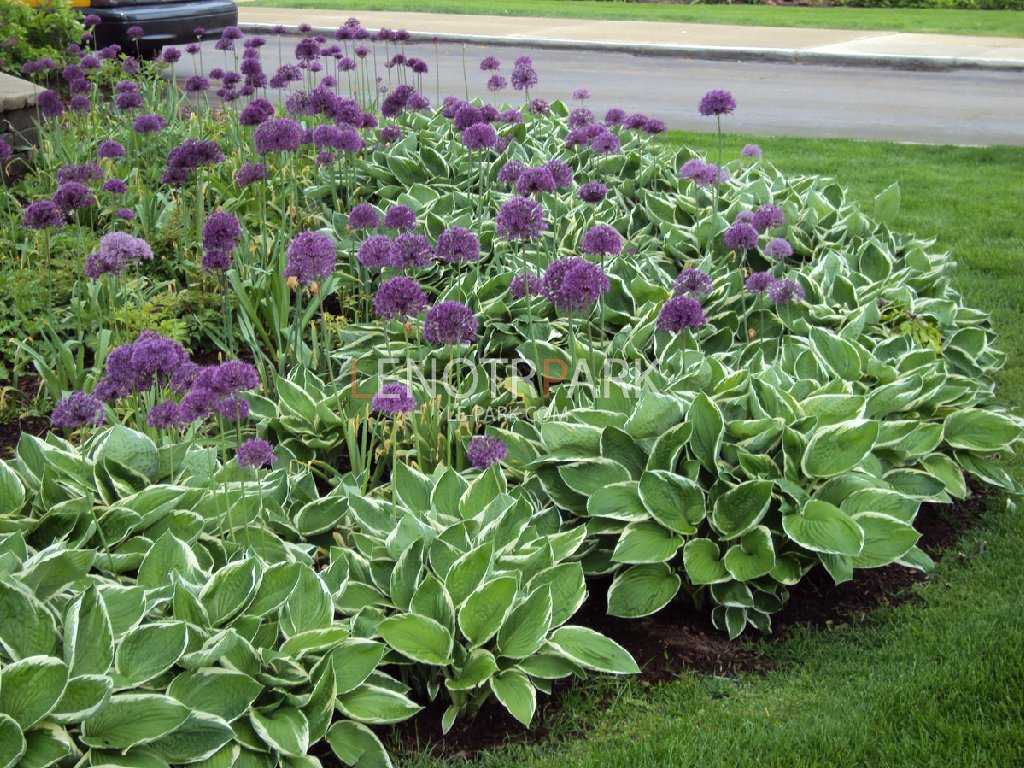 Next, it is recommended to outline the outer boundaries of your creation so that it looks more decorative. Stone or wooden borders, fine gravel (sea or river pebbles) or colored sand. As a last resort, you can trim the outermost parts of the turf. To make weeding a flower garden easier, the ground can be covered with peat or sawdust mulch. This will prevent weed growth and moisture evaporation, and will also serve as an additional soil fertilizer. You can water the plant by sprinkling using automatic watering. — best specialist garden care. In this case, watering should not be carried out during the hottest part of the day. Strive to ensure that the soil in your garden is always slightly moist.
Next, it is recommended to outline the outer boundaries of your creation so that it looks more decorative. Stone or wooden borders, fine gravel (sea or river pebbles) or colored sand. As a last resort, you can trim the outermost parts of the turf. To make weeding a flower garden easier, the ground can be covered with peat or sawdust mulch. This will prevent weed growth and moisture evaporation, and will also serve as an additional soil fertilizer. You can water the plant by sprinkling using automatic watering. — best specialist garden care. In this case, watering should not be carried out during the hottest part of the day. Strive to ensure that the soil in your garden is always slightly moist.
When plants fade, their flower stalks should be removed to give the area a neater appearance. In addition, this will promote re-blooming next season. At the end of autumn, it is necessary to remove the above-ground parts of the plants and strew the non-frost-resistant specimens with woody leaves. Bulbs and tubers of the corresponding plants need to be dug up and, after clearing the soil, put in boxes and stored in a barn or other suitable place.
Among the most common mistakes made in gardening
- undefined borders of the flower garden;
— planting non-viable plants;
- an incorrectly formed pillow in a flower garden;
— incorrectly selected flora in terms of color and structure;
— the presence in one flower bed of plants with different needs for soil qualities, lighting, and so on;
— incorrect arrangement of vegetation according to growth.
Price for creating flower beds
In the price list below you can see the cost of creating turnkey flower beds. The cost is approximate, the exact cost is calculated based on the floral arrangement plan. When ordering work, project development as a gift. The minimum cost of work is 10,000 rubles. Designers of the LENOTR-PARK company will develop an individual floral design project, a flower garden of continuous flowering especially for you. Entrust your garden to the Professionals!
Floral decoration – universal option for decoration as home interior, and the garden. Flower arrangements are relevant always and everywhere (for example, as in the photo).
It is almost impossible to imagine a site without a garden, flower beds, flower beds, or at least small flower arrangements. Options for using colors in landscape design a huge variety, the most common forms of floral decoration are:
- A flowerbed is a section of regular geometric shape. The flower and plant composition of flower beds can be very different or, conversely, consist entirely of identical plants (mono-bed).
- The front garden is often used as a floral decoration for a summer cottage.
- Rabatka is a narrow (0.5-1.5 m) elongated flower garden. As a rule, borders are laid along walls, fences, green lawns and paths.
- Arabesque is one of the most decorative types of flower beds, made in the form of a complex pattern.
- A border is a form that is used to frame flower beds, ridges, paths and give them a completed shape. As a rule, dwarf or ground cover plant species are used for borders.
- Mixborders are a mixed border, a type of flower garden suitable for any garden (as in the photo below). Both perennials and annual flowers are used to create compositions, taking into account seasonality. Therefore, creating a mixborder will take more than one year, but the work invested will be justified by the bright, beautiful flowering that will continue early spring until autumn. The size and shape of such flower beds are arbitrary.
In addition to regular flower beds, the floral design of the garden is often created with the help of seasonal plants.
Floral design techniques like container gardening can help brighten up areas where you haven't yet created flower beds and are perfect for decorating patios, patios, and patios.
![]()
Floral backgrounds are always appropriate for porch decoration. Here you can show your imagination and make an original design with your own hands.
When choosing for a garden, always consider the following points:
- The nature of the soil on the site and the groundwater level. Depending on this, select flowers for your flower beds.
- When choosing flowers for flower beds, consider the amount of sunlight they need. Do not give in to emotions when taking all the seedlings you like from the flower shop; sometimes in problematic shady areas or for flower beds around a tree it is better to abandon flowers altogether in favor of other decor.
- Always take into account the seasonality of flowering when creating compositions for the garden and individual flower beds.
- Only careful planning of all objects - from small compositions to central flower beds - will allow the garden to maintain its decorative appearance from early spring to late autumn (pictured). Do not neglect drawing up a dendroplane.
Types of floral interior decoration
The use of flowers in the interior is not just a decoration technique. Plants and flowers have a positive effect on the psychological and emotional climate in the room, and also increase productivity.
Florists distinguish the following main types of floral interior decoration:
Classic (traditional)
For such compositions, roses, irises, gladioli, carnations, lilies are used in combination with foliage and herbarium elements.
Crystal, porcelain vases or vessels with gold or silver plated are suitable for such bouquets.
Modern style
Mainly involves the use of exotic flowers. Callas, heliconias, antiriums and orchids are mainly placed in transparent vases, strict shapes, without unnecessary decoration.
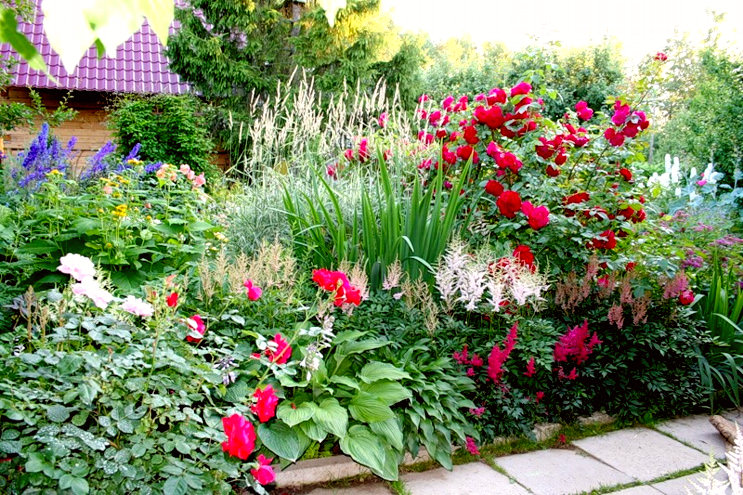
Victorian style
Involves the use of luxurious roses, lavender, freesias, gardenias and orchids.
The framing of such bouquets should correspond to the overall elegance of the style, so vases are chosen from crystal, gilded or silver plated (as in the photo).
Casual unobtrusive style
Suitable for neutral interiors. It is appropriate to use compositions from cyclamen, ivy, Kalanchoe, sunflowers and delphiniums. In general, there are no restrictions here, choose what you like.
Provincial style
Ideally combined with wildflowers: daisies, poppies, bluebells, cornflowers, wild roses, heather, etc. Such bouquets can be placed directly in a kitchen jug.
The most common way to decorate a room is to decorate tables with flowers using bouquets in vases.
As a rule, for such cases they resort to the help of experienced florists from a flower shop. But if you need to decorate a room for a special event, such services will not be cheap and no one can guarantee that the result will completely satisfy you.
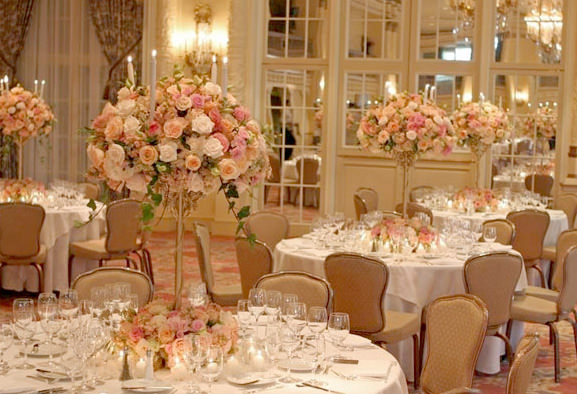
Moreover, for special occasions it is advisable to use at least several flower arrangements, and this is an even more expensive option. Therefore, do not be afraid to try your hand as a florist and adopt some original floral design techniques:
- It is not necessary to buy expensive vases from the store; any container can be draped with fabric that matches the style of the interior, as, for example, in the photo.
- Do not be afraid original design gift bouquets. Plain paper is always better than cellophane wrappers from the store, such a laconic wrapper will only emphasize natural beauty any compositions.
- Arranging bouquets is a whole science, but if you show your imagination, you can make an original and original one from even the simplest flowers. beautiful gift. Instead of banal ready-made bouquets from the store, use flowers from your own garden and unusual ideas, as, for example, in the photo below.
- Floral table decoration for special occasions requires a creative approach. Instead of splurging on expensive bouquets from the store, try your hand at creating unusual arrangements. Interesting idea for table decor - a combination of flowers, fruits and greenery. How beautiful it is can be appreciated by looking at the photo.
- In addition to bouquets, use other types of floral decoration: wreaths, garlands, floral decoration of individual interior items. Instead of single bouquets, try creating floral backdrops for your event using vertical arrangements (pictured).
Another option for floral interior decoration is flowers in pots. This seemingly familiar decoration technique can take on a completely new look if you show your imagination. You can experiment in several directions:

- Creating complex flower arrangements in one flowerpot. You can plant varieties of one type of flower in one flowerpot or add neutral greenery to the flower.
- Using other containers instead of traditional flowerpots, such as in the photo below.
- Original decor. An ordinary plastic or ceramic flowerpot from a store can turn into original decoration interior Decor flower pots with your own hands is an exclusively creative matter. It can be draped with fabric, pasted over with decorative details (as in the photo below) or using the decoupage technique.
- The highlight of the interior will be flowerpots placed instead of window sills in unusual places. The main thing is to choose the right flowers that will tolerate a possible lack of sunlight. Original flower pots can be a wonderful decoration for tables, shelves, chests of drawers, etc., not inferior in decorative value to expensive cut bouquets from the store.
Flower beds and flower beds
Creating flower beds in the garden is the final chord in the development of the site. This decorative element of garden design appears when the functional zones of the site are determined, paths are laid, trees and shrubs are planted, and a lawn is made.
When considering the variety of types of decoration of areas with flowers, it is necessary to take into account the layout of the territory, which can be regular (formal) and free (landscape), which corresponds to the two main styles in landscape architecture. The regular principle of organizing garden space is associated with the use of straight lines, symmetry and geometry. Landscape principles of garden design are more varied and complex than regular ones, and amaze the imagination with their perfection, beauty and grace. These are soft contours, many vantage points, a natural and organic connection with the surrounding nature, an ecological approach to the selection of an assortment of plants. Many elements are floral decorative design are universal and can be used in gardens with both a regular structure and landscape layout. Let's consider all the variety of types of flower beds for different decorative purposes.
Rabatka- a very impressive narrow rectangular strip of land from 50 to 150 cm wide, on which plants of the same height are planted. This is a very simple and understandable form; it is used by owners of small garden plots, because simple forms of ridges fit most harmoniously into small garden spaces.


The classic discount has clear construction rules. Its length must be at least three times the width. It can be one-sided or two-sided. The average height of the plants should be approximately 1/4 to 1/2 the width of the ridge. The ridges are placed against some background or most often along the paths - both on one and two sides. Along the walls of houses and fences, one-sided ridges are more appropriate, along paths - double-sided. Plants are planted in a simple geometric pattern of two or three colors. The design of an ornamental ridge usually consists of rhythmically alternating elements. The edge of the ridge is sometimes decorated with a border. Accenting is often used when designing it. In this case, the ridge is interrupted by an accent - a tall perennial or ornamental shrub.
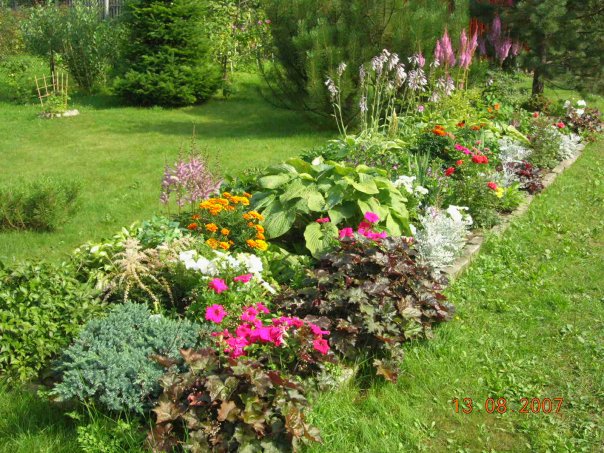

Flowerbed- the most common technique of floral decoration in a regular style. Used as an independent element of floral decoration or included in more complex species. This is a flower bed of regular geometric shape in the form of a circle, oval, rectangle, square or diamond. The size of the flower bed varies from 1 to 30 m in diameter and depends on the size of the plot.
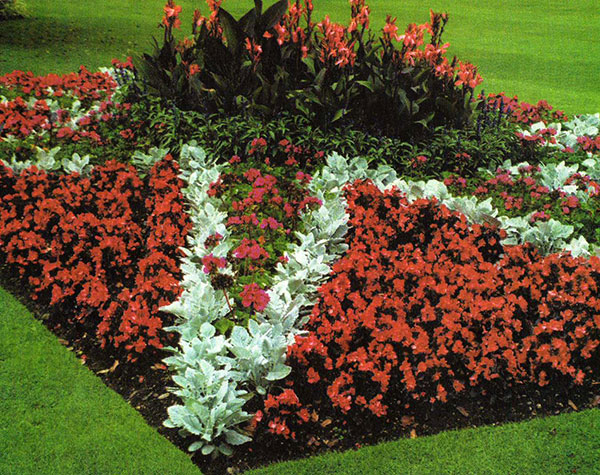

As a rule, plants in a flowerbed are planted in the form complex pattern. If the flower bed is small, 2-5 types of varieties are enough; for large areas, up to 10 types of flower crops will be required. If you need a long-lasting decorative flower garden, a removable flower arrangement is suitable: in the spring, bulbous (tulips, daffodils, hyacinths, small-bulbous), multi-flowering biennials (viola, forget-me-not, daisy) are planted, which are then changed to annuals and carpet plants. Flowerbeds are arranged in open spaces so that they can be viewed from all sides. For better perception, the edges of the flower bed should be raised above the soil level by 15-20 cm. If the diameter of the flower bed is more than 5 m, its surface is made convex, raising it by 5-10 cm for each meter of radius. Flowerbeds look good near the front entrance to the house, under the windows of the terrace, when the design is read from an elevated position. Small architectural forms are also used in the design of flowerbeds: vases, potted plants, sculptures. The height of the selected element should be no more than 1/3-1/4 of the diameter of the flower bed.
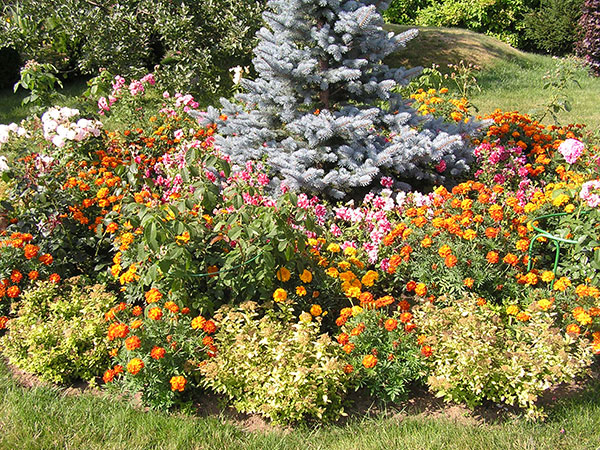
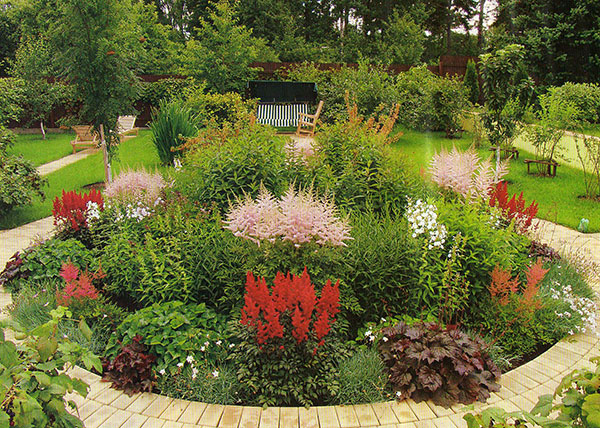
Border- most often made up of one type of low-growing compact plants, which are called border plants. Border plants should contrast in color with the main ones. decorative species, planted in a flower garden.
Both annual flower crops and low-growing perennials are used for borders. Borders border the contours of flower beds; they are located along paths or along the border of the lawn. The width of the border does not exceed 0.5 m, and the height of the planted plants ranges from 20 to 40 cm.
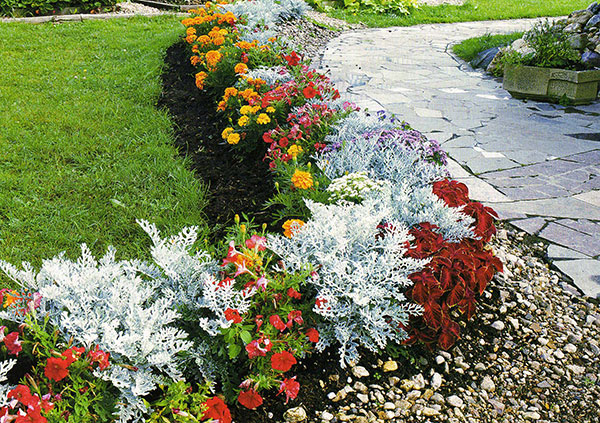

Mixborder- currently one of the most popular types of landscape flower beds, corresponding to the ecological approach to garden design. This is a flower garden of arbitrary shape, quite large in length and area, characterized by multiple changes in flowering during the growing season, in which plants of different groups can be combined (shrubs, perennials, annuals, bulbous plants). The choice of deciduous and coniferous trees, shrubs and flowers depends on the style and purpose of the garden. In terms of the structure and composition of plants, mixborder belongs to the natural style. You can arrange it in an open place, along the border of the site, under a canopy of trees, on a slope, where it will naturally fit into the surrounding space. When organizing a mixborder, you should consider how it will be viewed: from one or all sides. It is also important to note that mixbordering is an extraordinary way of expressing the idea of beauty with the help of flowers; it is a kind of pinnacle of gardening skill, to which true lovers of flower gardens come.



![]()
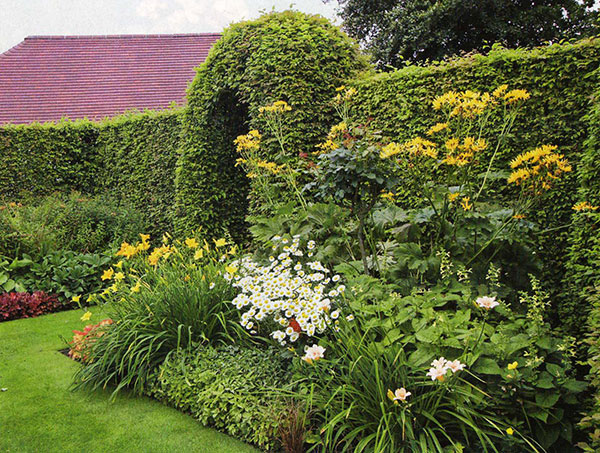
Flower group- the simplest and most common type of landscape floral design for a site. These are plantings consisting of plants of 5-8 species, each of which is presented in small quantity. The group has free outlines. Group plantings can be planted in the form of a round flower bed, a small bed, a border or an island flower bed. Such a flower garden is arranged on the lawn, against the backdrop of compositions of shrubs or under the canopy of sparse trees at a short distance from the view point. According to the composition of plants, a group can be made up of plants of the same or different species.
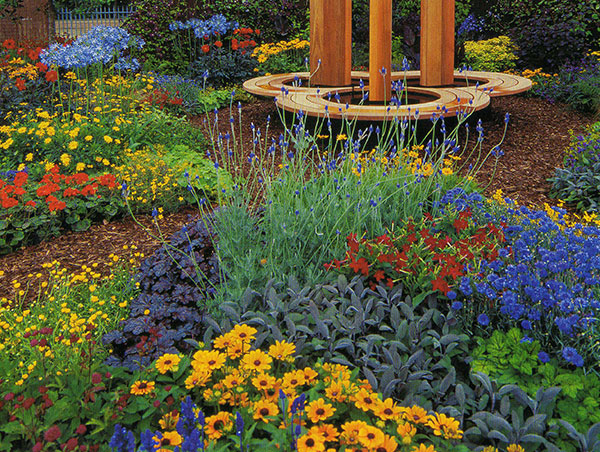

Selecting a group of plants of different species is quite difficult, and one has to take into account the parameters of environmental compatibility, the height of the plants, the timing of their flowering, and decorative features (the shape of the leaf blade and inflorescence, the color of the flowers). Depending on the time of use, groups can be seasonal or permanent. Seasonal groups are unusually impressive, since the plants in them bloom during a specific period: spring, summer or autumn.
Array- a large flower garden (from 20 sq.m.) of arbitrary shape, consisting of one type of perennials or different varieties of the same species, planted in large quantities. The array is located at a distance from the view point. When selecting plants, it is very important to consider how it will look before and after flowering. Plants are selected with bushes that do not fall apart and long-lasting foliage (volzhanka, astilbe, iris, daylily, hosta, fern, geranium, cereals). Arrays are used in park landscaping or in large areas. 

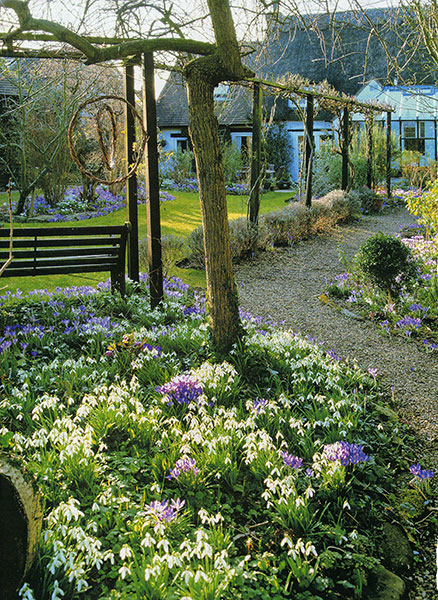
Rockeries and rock gardens- these elements of decorative design are often identified, their names are used as synonyms, but they are not the same thing. A rockery is a rock garden. The stones in it can be laid in ledges, at different heights, or installed on level ground. A rock garden is a structure made of soil and stones in the form of a hill or slope, on which plants of a certain type are planted, most often high-mountainous, “alpine” species, but often low plants of the steppes, deserts, and coasts, having a creeping or cushion-shaped form. Rock gardens may contain all kinds of bulbous plants, low ornamental shrubs and conifers.
Of course, rock gardens and rockeries located on the slopes are the “promised land” for ground cover plants. Numerous sedums, saxifrages, juveniles, primroses, carnations, thymes spread between the stones, gracefully descend from the ledges, filling most of the area of the rock garden or rock garden. The number of types of ground cover plants that can decorate rock gardens is very large: alyssum, arabis, alpine aster, speedwell, capitate knotweed, superb dicentra, Iberis everflowering, low bells, felt yarrow, subulate phlox and many others. Ground cover shrubs, such as cotoneasters - horizontal and pressed, rooting euonymus, as well as some heathers and ericas, also feel great here.
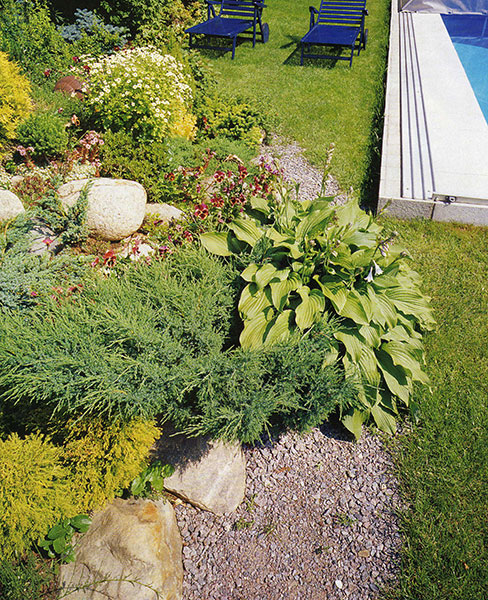

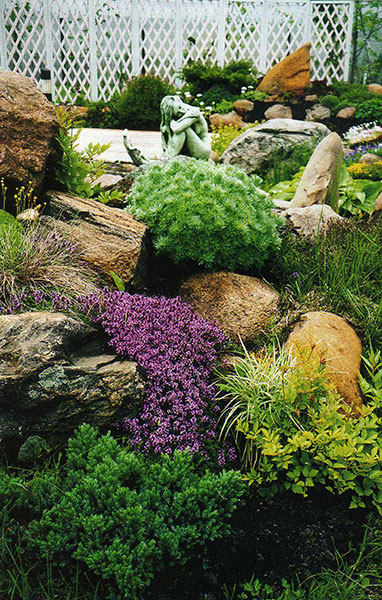
All these plants are planted in such a way that they form a multi-colored carpet, attractive from early spring to late autumn. But when planting plants, it is necessary to take into account the nature of their growth. A moth, for example, growing rapidly, can quickly occupy a large area, displacing its neighbors, so its growth must be strictly limited.
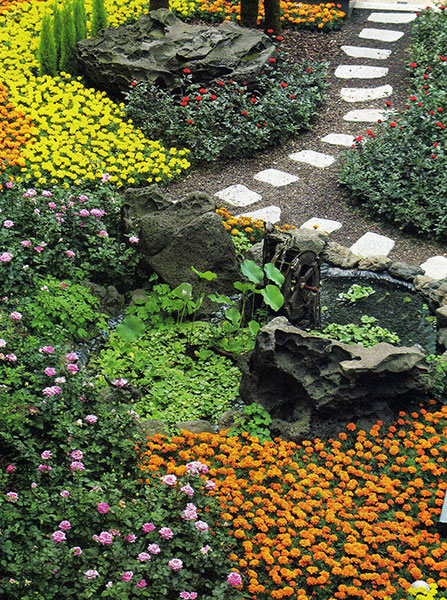
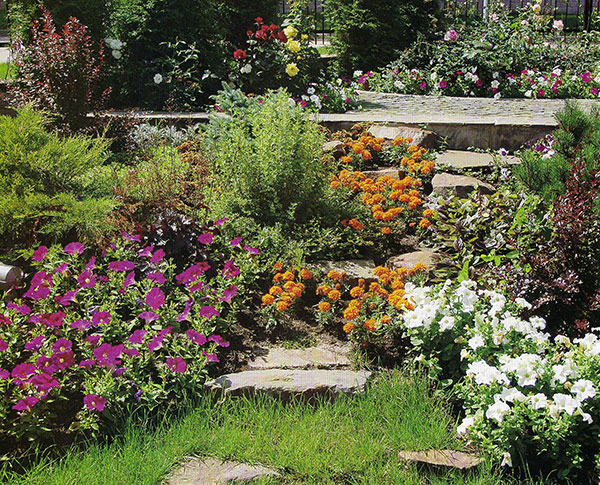
The rock garden is most beautiful in late spring - the first half of summer, when most ground cover plants bloom. At this time he reminds patchwork quilt. The rest of the time they look like mostly green, sometimes yellowish, bluish, purple or variegated mats of shoots with leaves. In the second half of summer they add bright color annual flowers in the hill - lobularia, lobelia, annual phlox, brachycoma, verbena, bindweed, eschscholzia, purslane. These plants, planted or sown on free places, remaining after the flowering of bulbous plants, delights until frost.
Gravel flower beds- This original variety a flower garden whose soil surface is covered with small stones - gravel, crushed stone or pebbles. In addition to stones, in such gardens you can use other materials lining the soil surface, both natural (shells, wood chips, nut shells) and artificial (pieces of glass, plastic, etc.). Plants in it are planted singly or in groups, but in such a way that a significant area (at least a third) of the cover remains free.
A gravel flower garden provides enormous opportunities for new design ideas. After all, besides plants, important decorative element here is the material covering the soil surface. Stones and other materials have different natural colors - dazzling white, gray, red, many shades of brown, brown, black, variegated, as well as different sizes, shapes, surface characteristics - chipped, rough or smooth. Avant-garde compositions can use stones and other materials painted in a variety of colors.
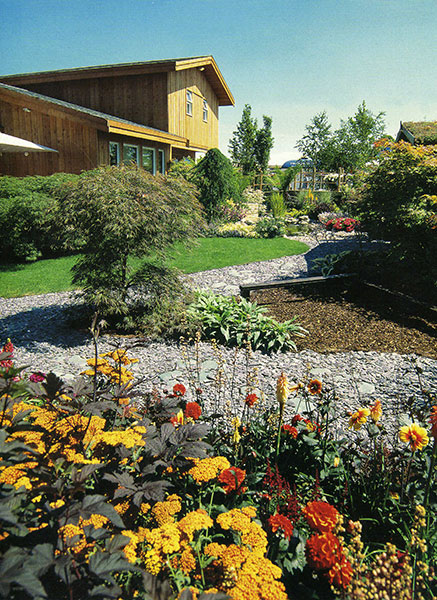

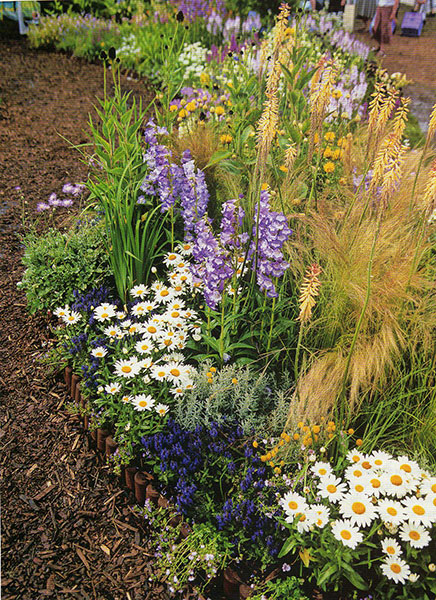
The big advantage of such a flower garden is its easy care. After all, if the flower garden is laid out in compliance with all the necessary requirements: the soil is properly prepared and thoroughly cleared of weeds, a separating layer of lutrasil (spunbond) is laid under the stones, an assortment of plants is thoughtfully selected, strongly growing aggressive plants are limited in growth (planted in containers), then care tending such a flower garden takes very little time and effort. It takes virtually no time to weed and loosen the soil, and you can quickly and easily clean the surface of stones from debris and leaves using a garden vacuum cleaner.
Place the gravel flower bed in well-lit areas: in a wide strip along the path, along the perimeter of a rock garden, pond, paved area, or as a spot of various, often irregular, shapes on the edge of the lawn.
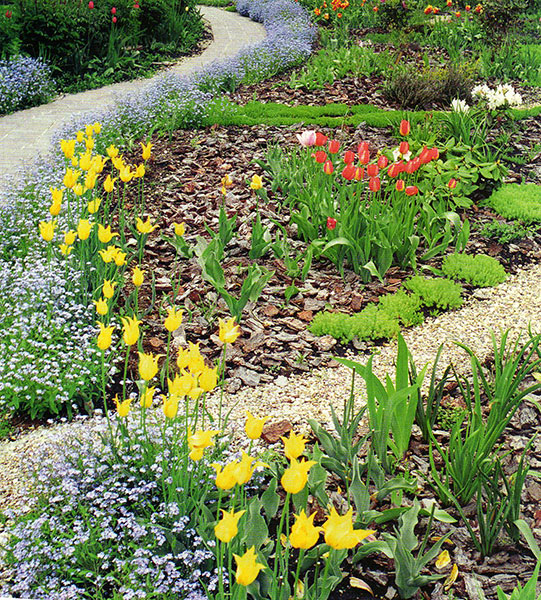
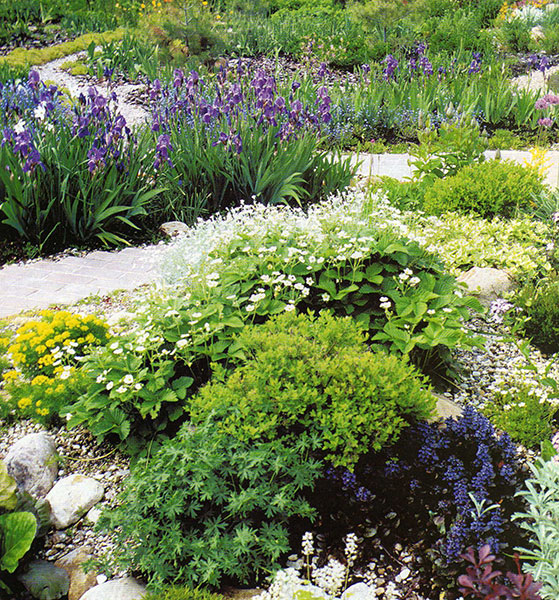
The choice of plants for a gravel flower garden must be approached very thoughtfully and carefully. Plants should not only be compatible with each other in size, color and shape, be non-aggressive and easy to care for, but also be in harmony with the material covering the soil. In such flower beds, it is desirable to use stable ornamental plants, that is, having an attractive appearance for a long time, and better yet, throughout the season. In classic gravel gardens, plants with large bright flowers, including annuals, as well as ephemeral plants that grow very a short time. The basis of the assortment for such compositions are ornamental grasses, as well as plants that resemble them in appearance (irises, daylilies, etc.), and ground cover plants with leaves of various colors, shapes, sizes and textures.
It is advisable to plant medium-sized plants - many cereals, daylilies, various irises - not individually, but in small groups. Among the cereals, against the background of stones, the clumps of sand grass with bright silvery leaves, bright green bushes of pike, yellow spots meadow foxtail.
Decorative ponds. Ground cover plants and a pond... This combination may seem strange at first glance. Of course, it is difficult to imagine any plant of this group covering the water surface - here is the place of plants adapted for life in water in a submerged or semi-submerged state, such as duckweed, pondweed, water lilies, water lilies, egg capsules and others. But a pond in a garden, as in nature, is not only a surface of water, but also a coastal zone, and this is where ground cover plants have the most freedom.


As for cereals, sedges, rushes, cattails, the abundance of light, warmth, moisture both in the reservoir itself and near it is just the right element for many of them.

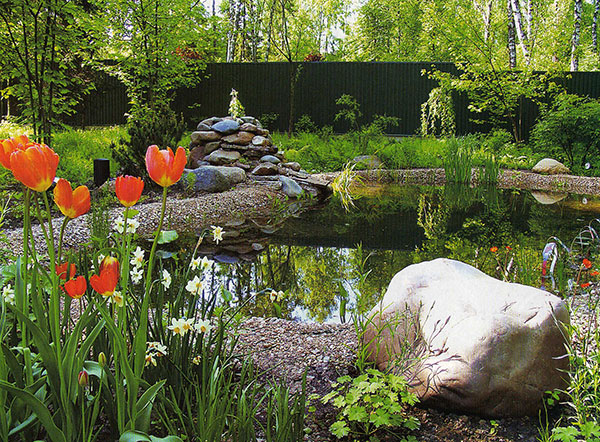
The choice of plants and the nature of the design of the coastal zone of the pond primarily depends on the style in which it was created. A wide variety of ground cover plants can be used, for example, when decorating the “Mountain Lake” composition, which often accompanies an alpine hill or a stream flowing from it. Here, in the crevices between the stones, you can plant many of the plants that were mentioned in the lines dedicated to the rock garden. Fluffy cushions of sedum, dense carpets of subulate phlox, alpine mantle, saxifrage will descend to the water itself, sometimes hanging over it. The high steep bank will be decorated with cascades of shoots of loosestrife with bright yellow leaves or white-variegated ivy-leaved budra, and on the slope between the stones clumps of fescue, feather grass, keleria, and Morrow sedge look very picturesque, creating a variegated green design of the reservoir.
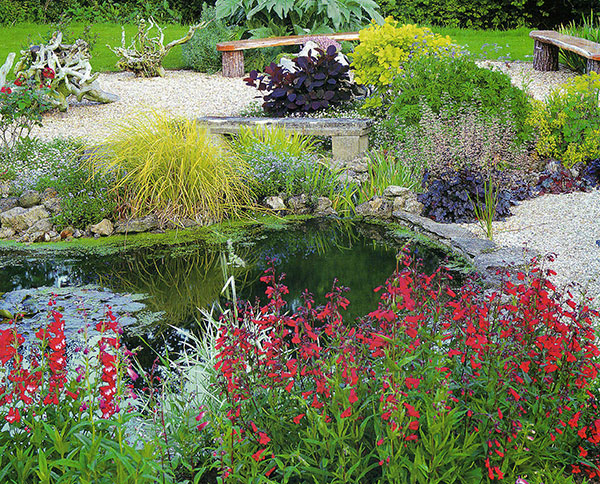
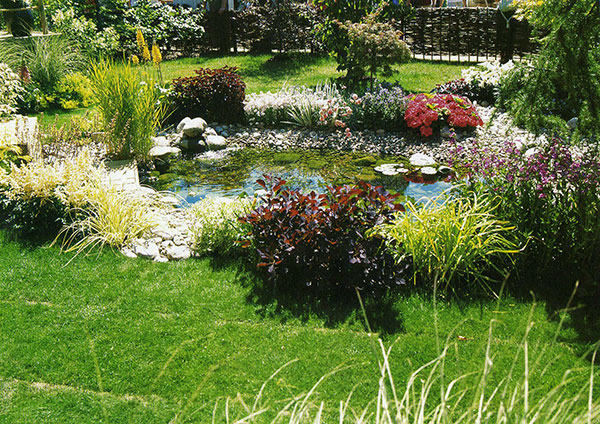
Low, calm banks of natural-style reservoirs are decorated in a more restrained manner, often using, in addition to cultural forms and varieties, plants of the local natural flora. On the front bank, closest to the path, low groundcovers are planted - mantles, geraniums, speedwells, knotweed, bergenia. Here you can also use coined loosestrife, and not its yellow-leaved form, but an ordinary species plant with green leaves and bright yellow flowers. On a low, damp bank, cordifolia or its varieties and forms with variegated leaves or double flowers are often planted.









